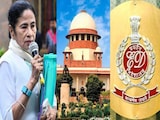Weeks after its report to the Madhya Pradesh High Court that the Bhojshala Temple-Kamal Maula Masjid in Dhar district was built from the remains of earlier temples, another statement by the Archaeological Survey of India has sparked heated debate in the state.
The centuries-old Vijay Surya Mandir in Vidisha has seen people from the Hindu community worshipping from outside its locked gates during 'Nag Panchami' every year but when permission was sought to go inside and conduct rituals during the festival this year, the Archaeological Survey of India (ASI) said the structure is actually the Bijamandal Mosque.
Some historians said the Vijay Surya Mandir, whose architecture is strikingly similar to the new Parliament House, was built in the 11th century by Chalukya Vanshi Vachaspati, the prime minister of the Paramara period ruler Raja Krishna, and its stones narrate the saga of the Paramara kings.
The doors of the temple were locked as part of an agreement between the administration and the Hindu and Muslim communities in 1965
When a section of Hindus sought permission to enter the temple and worship on 'Nag Panchami' this year - which was celebrated on Friday - the local administration, led by Collector Buddhesh Kumar Vaidya, consulted the ASI. They were informed that, according to a 1951 gazette notification, the site was registered as the Bijamandal Mosque and not a temple. Permission was then denied by the local administration.
Local Muslim leaders reiterated the historical significance of the Bijamandal Idgah.
Chaudhary Parvez Ahmed, acting president of the Muslim Society in Vidisha, said, "The Muslim community has been offering namaz in the Bijamandal Idgah Mosque for a long time. An agreement was made in 1965 and we stand firm on that. The idgah mosque was built by the government, and the land was purchased from the property handed over to us."
Another local resident, Abid Siddiq, added, "An agreement was made, and if we return the structure, we will hand it over only to the Muslims."
He emphasised the city's history of communal brotherhood and expressed gratitude to the administration for maintaining harmony, while also calling for the status quo to be maintained.
Temple Committee
In response to the ASI's stance, the Vijay Mandir Mukti Seva Samiti was formed in Vidisha under the leadership of BJP MLA Mukesh Tandon. The committee submitted a memorandum to the collector and superintendent of police, demanding a second survey of the site, and Mr Tandon argued that the structure's history and the community's sentiments should be given due consideration.
The local population remains divided on the issue. A resident, Rakesh Sharma, said, "The collector called it a mosque, but it was a temple. We worship here on 'Nag Panchami', and there is anger among the citizens... Every year, we perform rituals from outside the locked gates, but this time we thought of doing it from inside. The collector wrongly declared it a mosque."
Additional Superintendent of Police Prashant Choubey said law and order would be maintained in the area, regardless of the outcome of the committee's demand.
Excavations In 1934
Historians said the Vijay Surya Mandir has faced numerous challenges throughout its history and was attacked five times during the Mughal period, with the final assault being carried out by Aurangzeb, who demolished the temple and constructed a mosque - known as the Alamgiri Mosque - in its place. The temple gained prominence again during the reign of the Maratha kings but fell into disrepair and was submerged in floodwaters.
The temple's remains were rediscovered during excavations in 1934.
Historian Arvind Sharma said, "The temple was completed during the rule of Naravarman of the Paramara dynasty, which flourished in central India during the medieval period. The temple was a testament to the craftsmanship and devotion of the era, touching an impressive height of approximately 305 feet, as noted by the famous Persian scholar and historian al-Biruni. Its towering structure, adorned with intricate carvings and massive stones, was designed to reflect the grandeur of the sun god it was dedicated to."
The temple's architectural layout, with its triangular shape and big pillars, is believed to have influenced the design of several other significant structures in India, including the new Parliament House in New Delhi.
The Hindu Mahasabha played a crucial role in the temple's modern history, agitating for its restoration.














